Analysis of Fault Influence on Geostress Perturbation Based on Fault Model Test
Abstract
1. Introduction
2. Fault Physical Model Test
2.1. Test Equipment
2.2. Similarity Coefficient
2.3. Similar Model
2.4. Test Process
2.5. Results of Physical Model Tests
3. Displacement Field Inversion
3.1. Numerical Simulation Scheme
3.2. Analysis of Sensitive Factors of Fault Displacement
3.3. Numerical Simulation Results of Displacement Field
4. Fault Physical Model Test
4.1. Single-Fault Analysis
4.2. Multi-Fault Analysis
4.3. Simulation Results of Multi-Fault Model
5. Conclusions
- The impact of faults on reservoirs manifests as the dislocation-induced displacement of the reservoir rock mass. Results from physical model tests indicate that the displacement caused by strike-slip faults is less than that caused by reverse faults; furthermore, low-angle reverse faults induce greater displacement than high-angle reverse faults;
- In the numerical simulation of faults, the cohesion, internal friction angle, and shear stiffness of the fault interface element are all negatively correlated with the displacement difference across the fault sides. Quantitative analysis using the coefficient of variation method to determine the influence weights of these parameters on the displacement difference between the fault sides indicates that shear stiffness is the predominant factor affecting the displacement difference across the fault;
- The outcomes of multi-fault stress field simulations illustrate that faults typically cause a reduction in the horizontal principal stress at the fault locations. However, the extent of geostress reduction and the range of its influence vary among different faults, with the most extensive influence spanning up to 310 m.
Author Contributions
Funding
Data Availability Statement
Conflicts of Interest
References
- Addis, M. The geology of geomechanics: Petroleum geomechanical engineering in field development planning. Geol. Soc. Spec. Publ. 2017, 458, 7–29. [Google Scholar] [CrossRef]
- Fjær, E. Geomechanics and geophysics for reservoir management. Rev. Eur. Génie Civ. 2006, 10, 703–730. [Google Scholar] [CrossRef]
- Yang, S.; Wu, G.; Zhu, Y.; Zhang, Y.; Zhao, X.; Lu, Z.; Zhang, B. Key oil accumulation periods of ultra-deep fault-controlled oil reservoir in northern Tarim Basin, NW China. Pet. Explor. Dev. 2022, 49, 285–299. [Google Scholar] [CrossRef]
- McClay, K.; Ellis, P. Geometries of extensional fault systems developed in model experiments. Geology 1987, 15, 341–344. [Google Scholar] [CrossRef]
- Vendeville, B. Mechanisms generating normal fault curvature: A review illustrated by physical models. Geol. Soc. Spec. Publ. 1991, 56, 241–249. [Google Scholar] [CrossRef]
- Keating, D.P.; Fischer, M.P.; Blau, H. Physical modeling of deformation patterns in monoclines above oblique-slip faults. J. Struct. Geol. 2012, 39, 37–51. [Google Scholar] [CrossRef]
- Lin, M.; Chung, C.; Jeng, F. Deformation of overburden soil induced by thrust fault slip. Eng. Geol. 2006, 88, 70–89. [Google Scholar] [CrossRef]
- Bois, T.; Bouissou, S.; Guglielmi, Y. Influence of major inherited faults zones on gravitational slope deformation: A two-dimensional physical modelling of the La Clapière area (Southern French Alps). Earth Planet. Sci. Lett. 2008, 272, 709–719. [Google Scholar] [CrossRef]
- Mou, Y.; Liang, H.; Su, N.; Guo, W.; Pei, Y. Control of pre-existing faults on transtensional and transpressional fault systems: A perspective from analogue modelling. J. Asian Earth Sci. 2023, 252, 105689. [Google Scholar] [CrossRef]
- Zhang, X.; Shen, Y.; Qiu, J.; Chang, M.; Zhou, P.; Huang, H.; Zhu, P. Failure and deformation mode for soil and tunnel structure crossing multiple slip surfaces of strike-slip fault in model test. Soil. Dyn. Earthq. Eng. 2024, 179, 108541. [Google Scholar] [CrossRef]
- Bonini, L.; Fracassi, U.; Bertone, N.; Maesano, F.E.; Valensise, G.; Basili, R. How do inherited dip-slip faults affect the development of new extensional faults? Insights from wet clay analog models. J. Struct. Geol. 2023, 169, 104836. [Google Scholar] [CrossRef]
- Martin, C.D.; Chandler, N.A. Stress heterogeneity and geological structures. Int. J. Rock Mech. Min. Sci. Geomech. Abstr. 1993, 30, 993–999. [Google Scholar] [CrossRef]
- Zoback, M.D.; Zoback, M.L.; Mount, V.S.; Suppe, J.; Eaton, J.P.; Healy, J.H.; Oppenheimer, D.; Reasenberg, P.; Jones, L.; Raleigh, C.B. New evidence on the state of stress of the San Andreas fault system. Science 1987, 238, 1105–1111. [Google Scholar] [CrossRef] [PubMed]
- Tingay, M.; Muller, B.; Reinecker, J.; Heidbach, O. State and origin of the present-day stress field in sedimentary basins: New results from the World Stress Map Project. In Proceedings of the Golden Rocks 2006, the 41st U.S. Symposium on Rock Mechanics (USRMS), Golden, CO, USA, 17–21 June 2006; ARMA: Alexandria, VA, USA,, 2006; p. ARMA-06-1049. [Google Scholar]
- Wang, K.; Dai, J.; Liu, H.; Li, Q.; Zhao, L. Characteristic of current in-situ stress field in Keshen gas field, Tarim Basin. Zhongnan Daxue Xuebao (Ziran Kexue Ban)/J. Cent. South Univ. (Sci. Technol.) 2015, 46, 941–951. [Google Scholar]
- Congro, M.; Zanatta, A.S.; Nunes, K.; Quevedo, R.; Carvalho, B.R.; Roehl, D. Determination of fault damage zones in sandstone rocks using numerical models and statistical analyses. Geomech. Energy Environ. 2023, 36, 100495. [Google Scholar] [CrossRef]
- Zhang, J.; Zhang, Z.; Wang, B.; Deng, S. Development pattern and prediction of induced fractures from strike-slip faults in Shunnan area, Tarim Basin. Oil Gas Geol. 2018, 39, 955–963+1055. [Google Scholar]
- Zhang, B.; Hu, X.; Wang, Y.; Hu, Y.; Chen, W. In situ stress inversion and fracture characteristics around local fault in deep heterogeneous strata. Pet. Sci. Technol. 2024, 42, 448–469. [Google Scholar] [CrossRef]
- Jiao, Z.; Wang, L.; Zhang, M.; Wang, J. Numerical simulation of mining-induced stress evolution and fault slip behavior in deep mining. Adv. Mater. Sci. Eng. 2021, 2021, 1–14. [Google Scholar] [CrossRef]
- Chen, B.; Ren, Q.; Wang, F.; Zhao, Y.; Liu, C. Inversion analysis of in-situ stress field in tunnel fault zone considering high geothermal. Geotech. Geol. Eng. 2021, 39, 5007–5019. [Google Scholar] [CrossRef]
- Yoon, J.S.; Zang, A.; Stephansson, O. Numerical investigation on optimized stimulation of intact and naturally fractured deep geothermal reservoirs using hydro-mechanical coupled discrete particles joints model. Geothermics 2014, 52, 165–184. [Google Scholar] [CrossRef]
- Sun, L.; Zhu, Y. The research progress on numerical analysis method of initial geostress. Seismol. Geomagn. Obs. Res. 2008, 29, 14–21. [Google Scholar]
- Cappa, F.; Rutqvist, J. Impact of CO2 geological sequestration on the nucleation of earthquakes. Geophys. Res. Lett. 2011, L17313, 1–6. [Google Scholar] [CrossRef]
- Shen, H.; Cheng, Y.; Zhao, Y.; Zhang, J.; Xia, Y. Study on influence of faults on geostress by measurement data and numerical simulation. Yanshilixue Yu Gongcheng Xuebao/Chin. J. Rock. Mech. Eng. 2008, 27, 3985–3990. [Google Scholar]
- Zhu, A.; Zhang, D.; Jiang, C. Numerical simulation of the segmentation of the stress state of the Anninghe-Zemuhe-Xiaojiang faults. Sci. China Earth Sci. 2016, 59, 384–396. [Google Scholar] [CrossRef]
- Cai, S. Research and Application of Contact Surface Method and Weakening Method in FLAC3D Fault Simulation. Master’s Thesis, China University of Mining and Technology, Xuzhou, China, 2016. [Google Scholar]
- Yu, Y. Evaluation of weighting methods in multi-index comprehensive evaluation. Stat. Decis. 2006, 13, 17–19. [Google Scholar]
- Brudy, M.; Zoback, M.; Fuchs, K.; Rummel, F.; Baumgärtner, J. Estimation of the complete stress tensor to 8 km depth in the KTB scientific drill holes: Implications for crustal strength. J. Geophys. Res. Solid. Earth 1997, 102, 18453–18475. [Google Scholar] [CrossRef]
- Tamagawa, T.; Pollard, D.D. Fracture permeability created by perturbed stress fields around active faults in a fractured basement reservoir. AAPG Bull. 2008, 92, 743–764. [Google Scholar] [CrossRef]
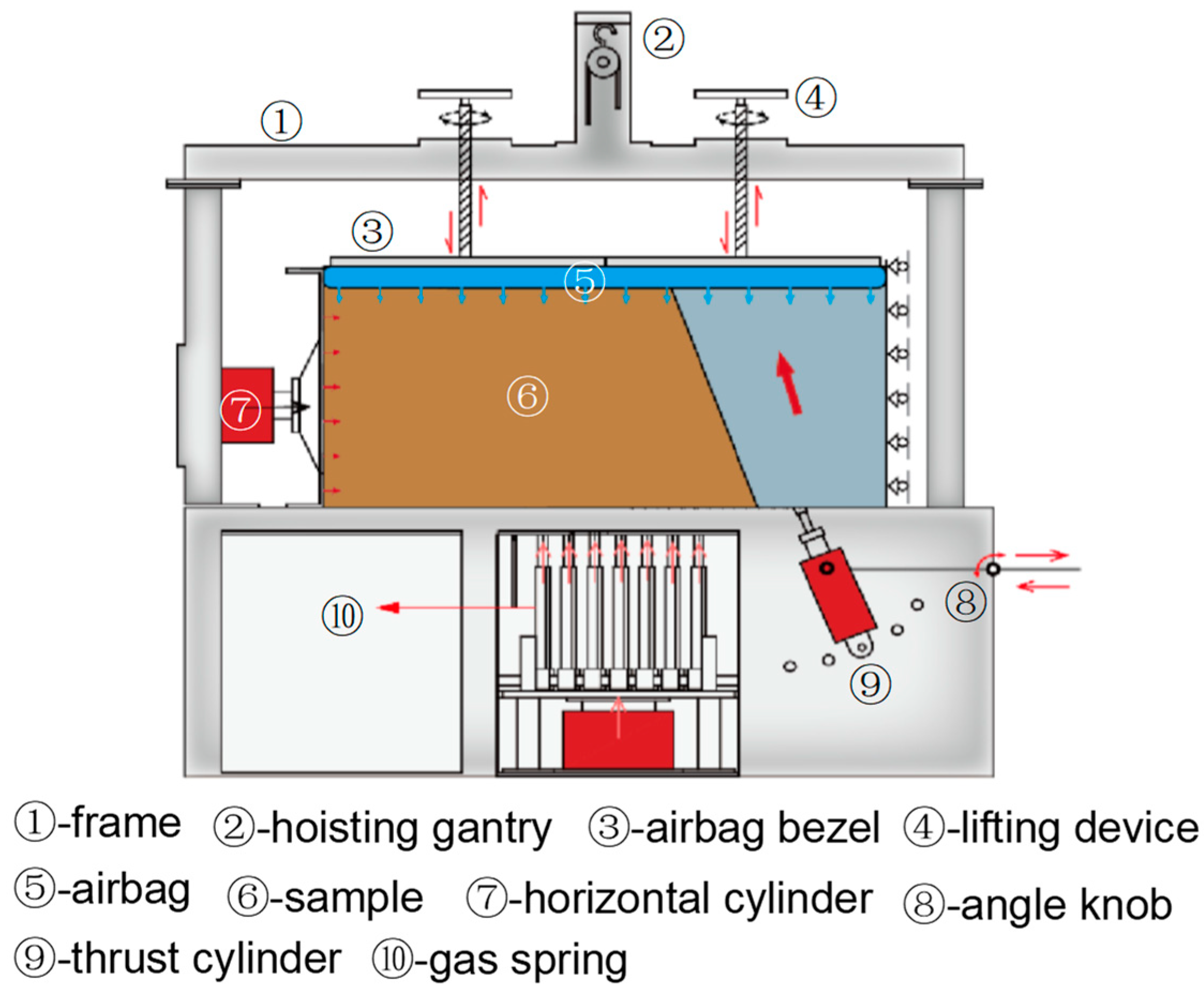

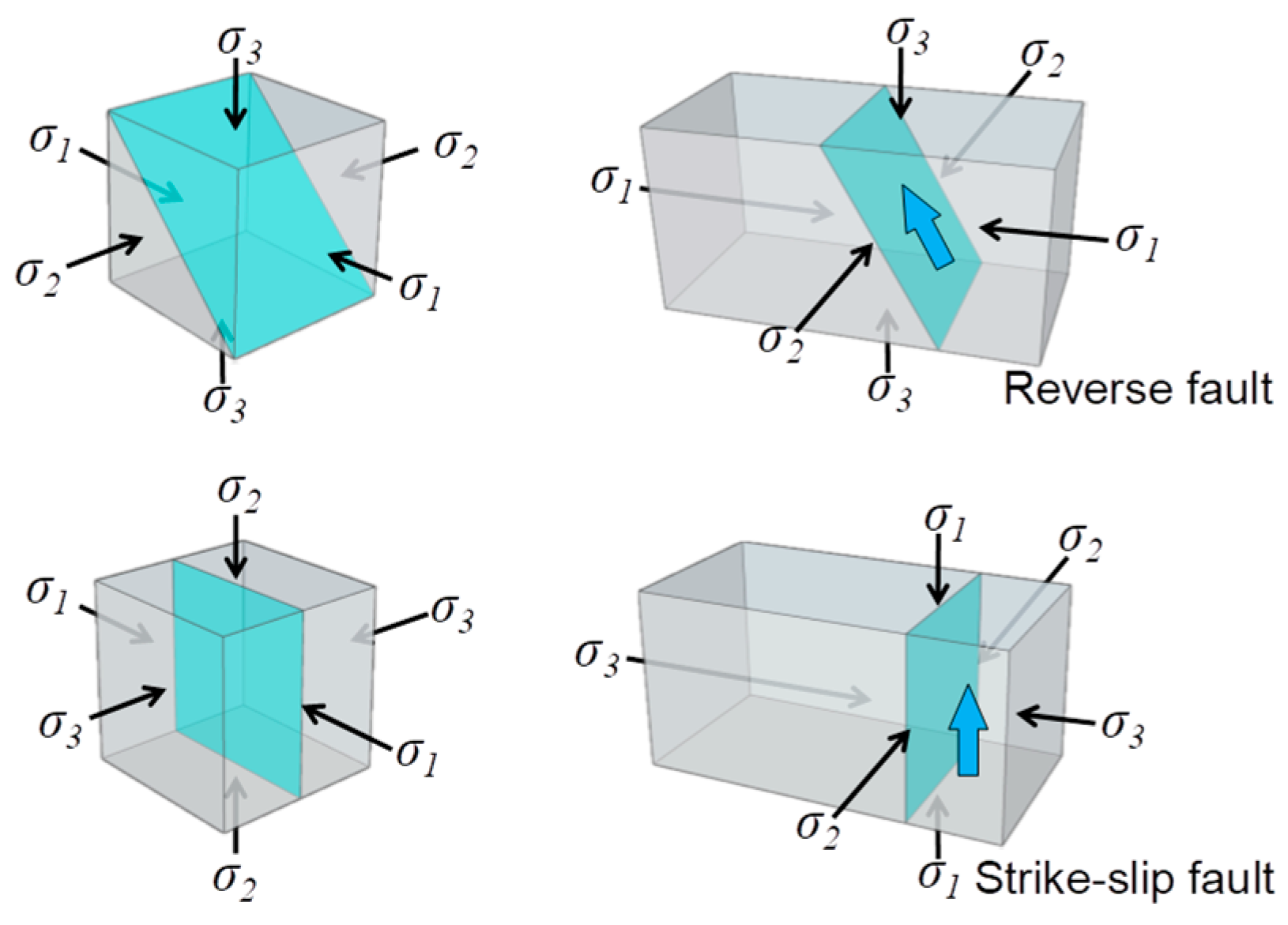


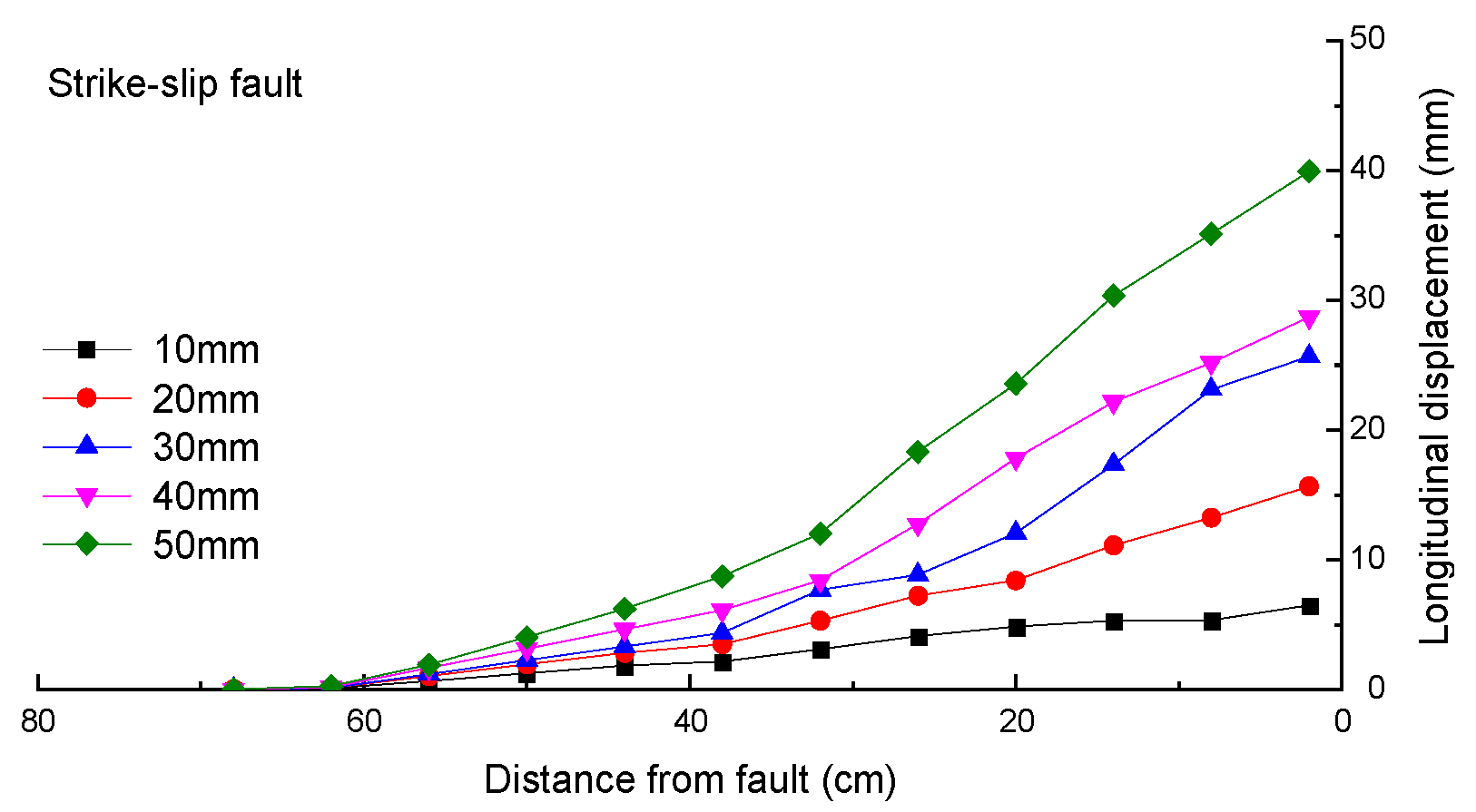
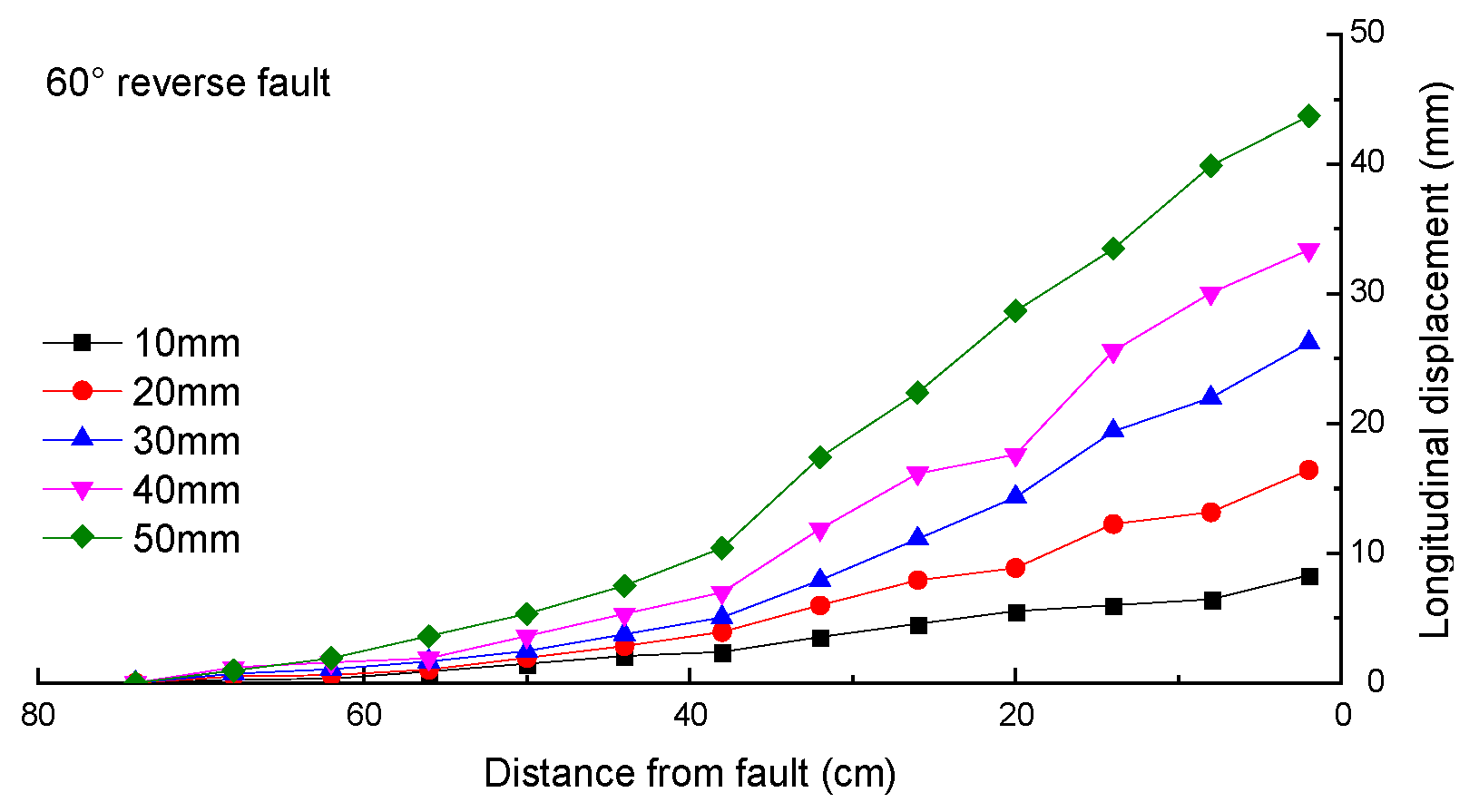
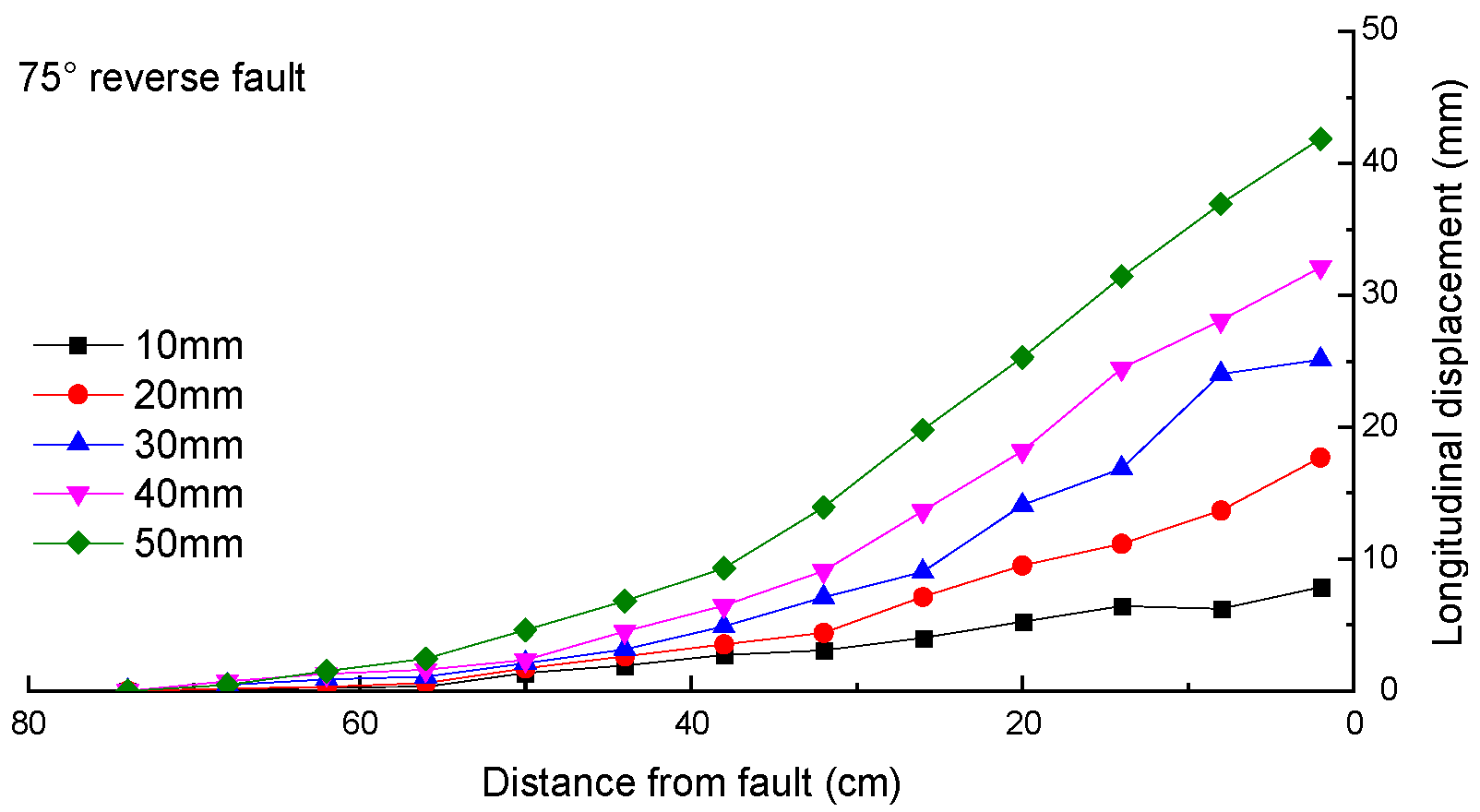
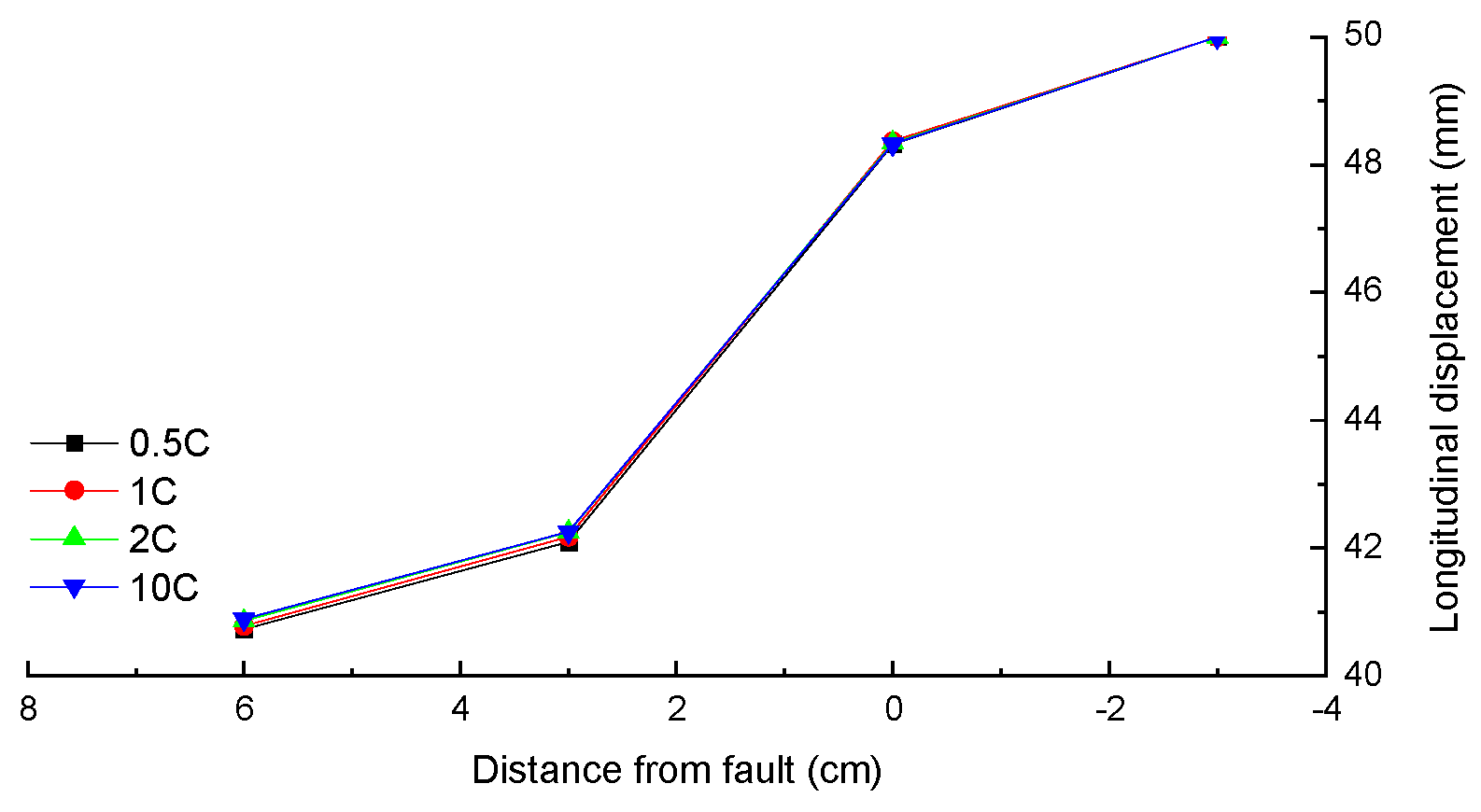
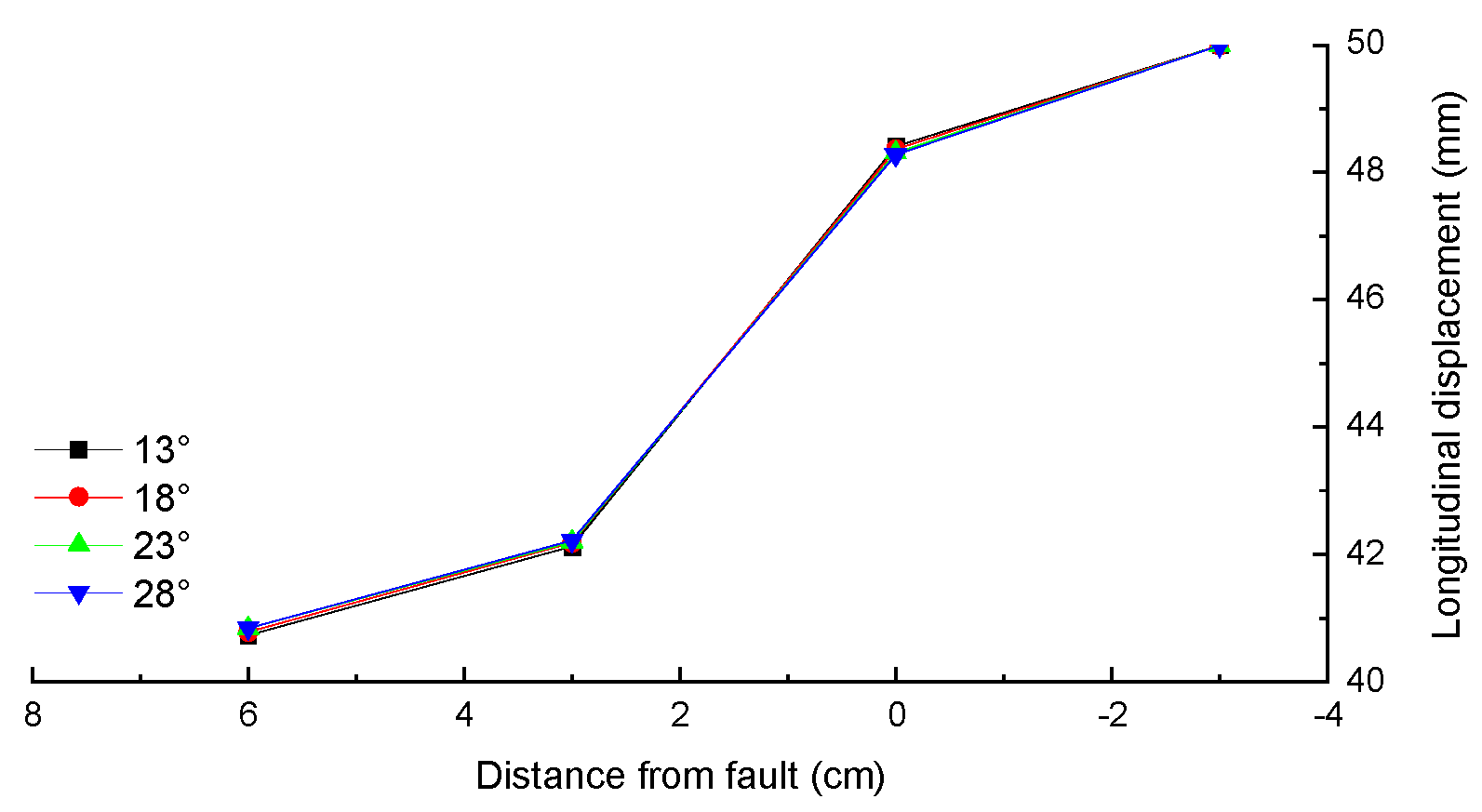

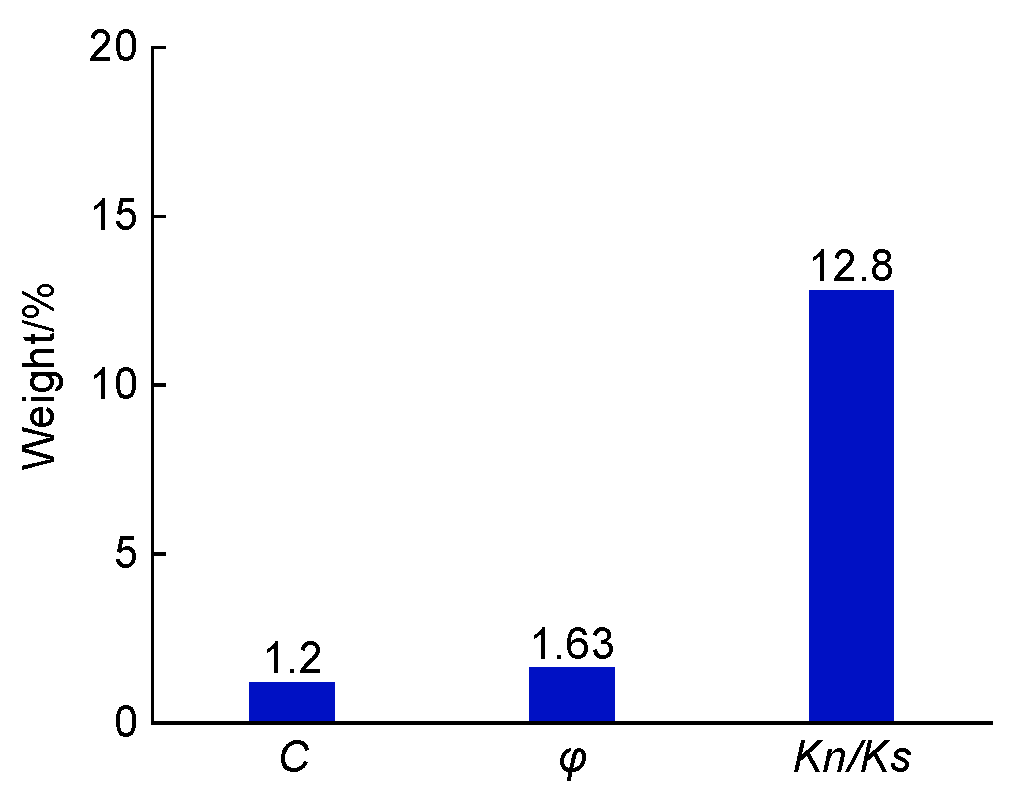


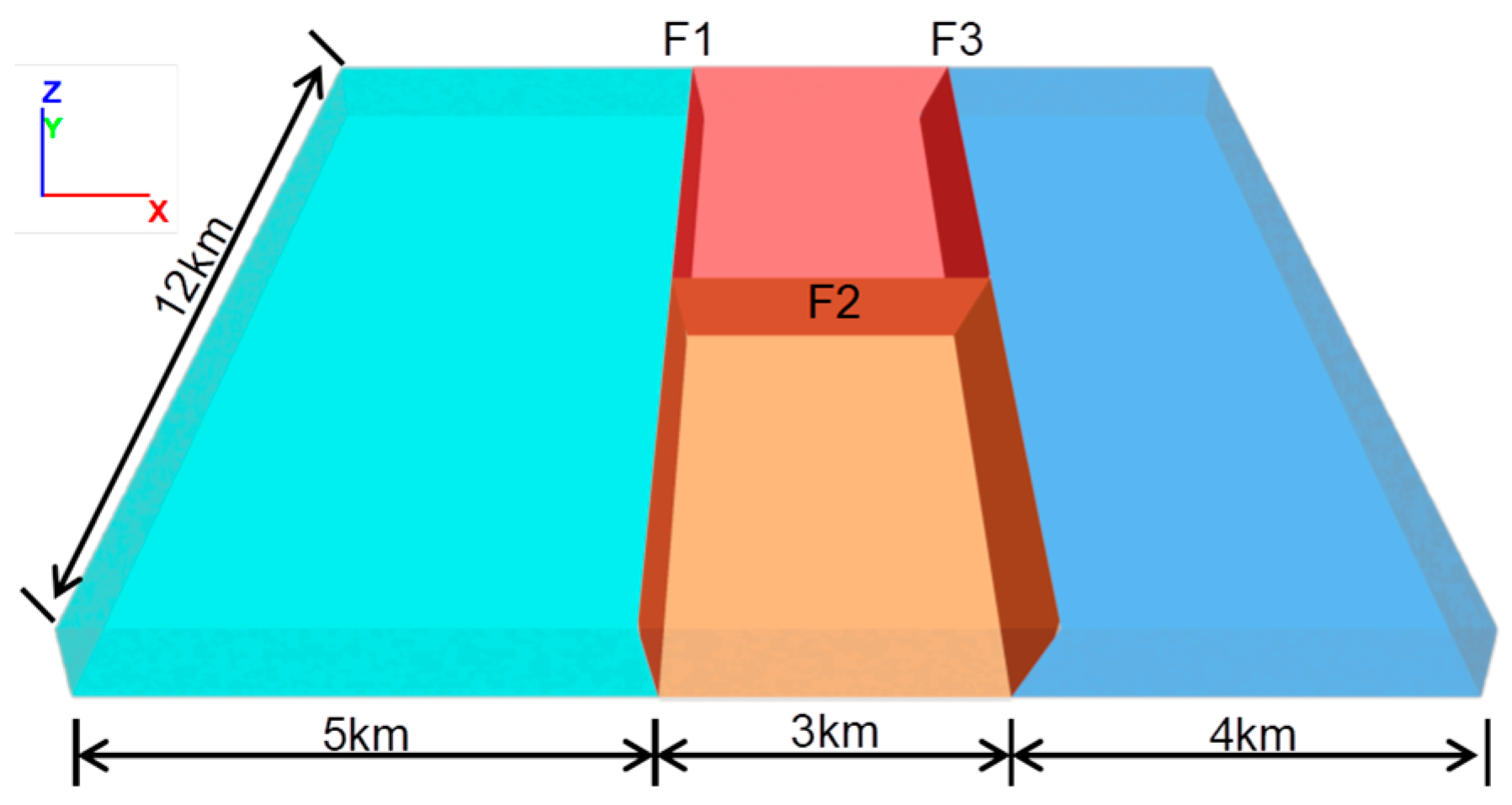
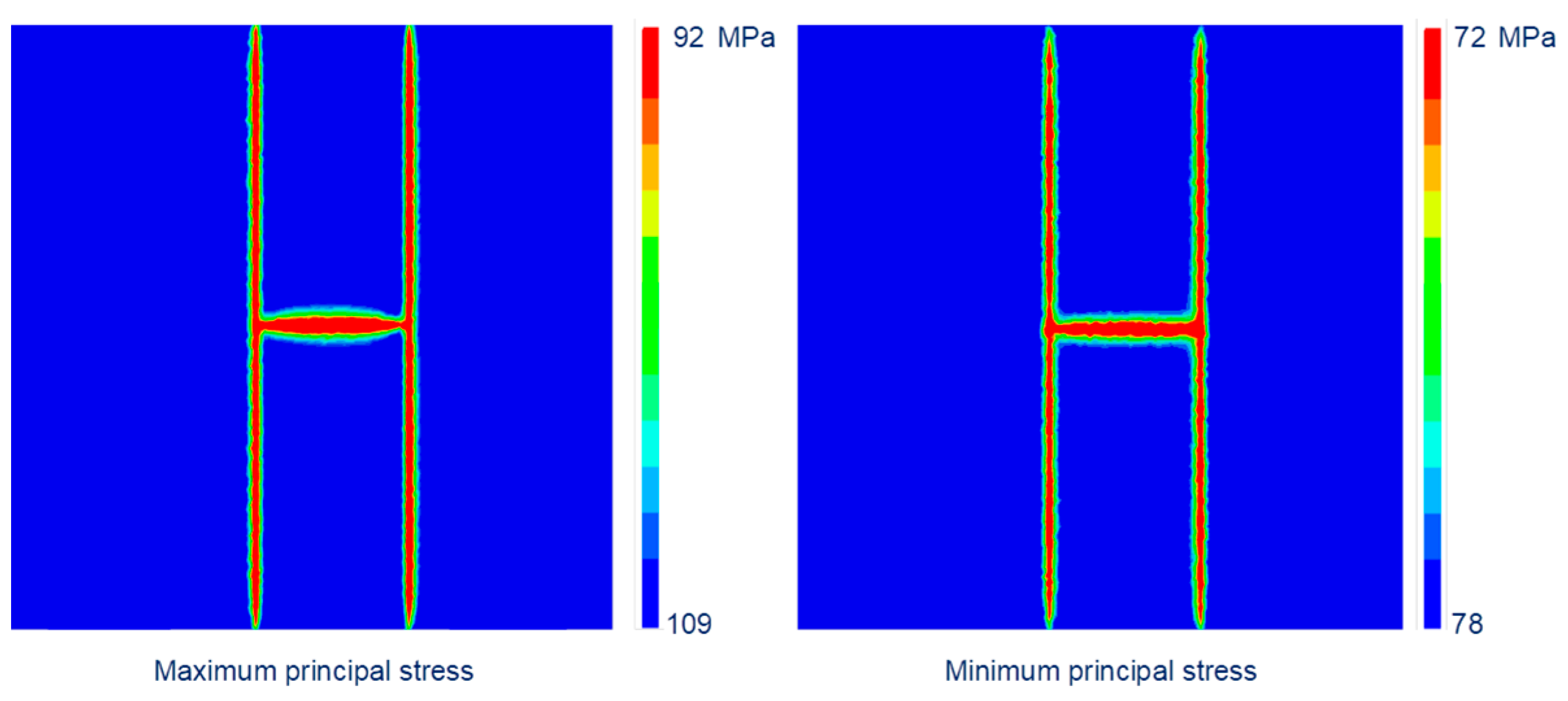

| Category | Similarity Parameters | Similarity Coefficient | Similarity Relationship |
|---|---|---|---|
| Density | Cγ | 1 | / |
| Geometry | CL | 240 | CL = Cσ/Cγ |
| Stress | Cσ | 240 | Cσ = CLCγ |
| Elastic modulus | CE | 240 | Cσ = CECε |
| Boundary stress | Cp | 240 | CE = Cp |
| Poisson’s ratio | Cν | 1 | Cν = Cε |
| Strain | Cε | 1 | / |
| Material Type | Severity (kN/m3) | Elastic Modulus (GPa) | Poisson’s Ratio |
|---|---|---|---|
| Actual rock mass | 23.9 | 26.80 | 0.20 |
| Similar materials | 23.2 | 0.11 | 0.20 |
| Shear Stiffness Ks (GPa) | Cohesion C (MPa) | Internal Friction Angle φ (°) |
|---|---|---|
| 0.18 | 15 | 12 |
| Element Properties | Modulus of Elasticity (GPa) | Poisson’s Ratio | Normal Stiffness (GPa) | Shear Stiffness (GPa) | Cohesion (MPa) | Internal Friction Angle (°) |
|---|---|---|---|---|---|---|
| Reservoir | 24.95 | 0.18 | / | / | / | / |
| F1 | / | / | 1.42 | 1.42 | 23 | 21 |
| F2 | / | / | 0.94 | 0.94 | 16 | 17 |
| F3 | / | / | 1.57 | 1.57 | 19 | 20 |
| Fault | a (σH) | b (σH) | a (σh) | b (σh) |
|---|---|---|---|---|
| F1 | 16.85 | −0.005142 | 4.40 | −0.007573 |
| F2 | 11.49 | −0.004471 | 7.05 | −0.006101 |
| F3 | 15.01 | −0.006211 | 6.06 | −0.007139 |
| F1 σH | F1 σh | F2 σH | F2 σh | F3 σH | F3 σh | |
|---|---|---|---|---|---|---|
| Distance (m) | 269.60 | 183.06 | 310.06 | 194.17 | 223.20 | 227.22 |
Disclaimer/Publisher’s Note: The statements, opinions and data contained in all publications are solely those of the individual author(s) and contributor(s) and not of MDPI and/or the editor(s). MDPI and/or the editor(s) disclaim responsibility for any injury to people or property resulting from any ideas, methods, instructions or products referred to in the content. |
© 2024 by the authors. Licensee MDPI, Basel, Switzerland. This article is an open access article distributed under the terms and conditions of the Creative Commons Attribution (CC BY) license (https://creativecommons.org/licenses/by/4.0/).
Share and Cite
Tian, S.; Qiao, Y.; Zhang, Y.; Hu, D.; Zhou, H.; Iqbal, S.M. Analysis of Fault Influence on Geostress Perturbation Based on Fault Model Test. Processes 2024, 12, 1240. https://doi.org/10.3390/pr12061240
Tian S, Qiao Y, Zhang Y, Hu D, Zhou H, Iqbal SM. Analysis of Fault Influence on Geostress Perturbation Based on Fault Model Test. Processes. 2024; 12(6):1240. https://doi.org/10.3390/pr12061240
Chicago/Turabian StyleTian, Shuang, Yan Qiao, Yang Zhang, Dawei Hu, Hui Zhou, and Sayed Muhammad Iqbal. 2024. "Analysis of Fault Influence on Geostress Perturbation Based on Fault Model Test" Processes 12, no. 6: 1240. https://doi.org/10.3390/pr12061240
APA StyleTian, S., Qiao, Y., Zhang, Y., Hu, D., Zhou, H., & Iqbal, S. M. (2024). Analysis of Fault Influence on Geostress Perturbation Based on Fault Model Test. Processes, 12(6), 1240. https://doi.org/10.3390/pr12061240





